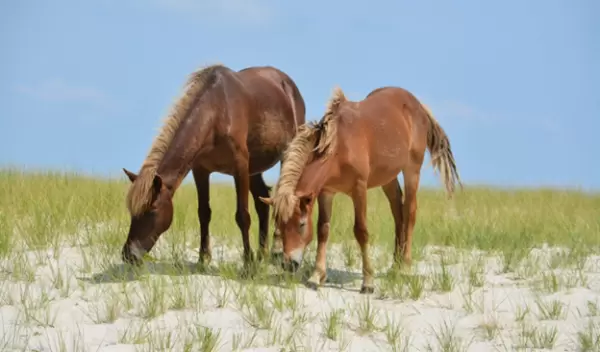
Oldest DNA from domesticated American horse lends credence to shipwreck theory
An abandoned Caribbean colony unearthed centuries after it had been forgotten and a case of mistaken identity in the archaeological record have conspired to rewrite the history of Assateague, a barrier island off the Virginia and Maryland coasts.
These seemingly unrelated threads were woven together when Nicolas Delsol, a researcher at the Florida Museum of Natural History, set out to analyze ancient DNA recovered from cow bones found in archaeological sites. "I was sequencing mitochondrial DNA from fossil cow teeth and realized something was very different with one of the specimens when I analyzed the sequences," says Delsol.
That's because the specimen in question, a fragment of an adult molar, wasn't a cow tooth at all, but once belonged to a horse. According to a U.S. National Science Foundation-supported study published in the journal PLOS ONE, the DNA obtained from the tooth is also the oldest ever sequenced for a domesticated horse from the Americas.
The tooth was excavated from Puerto Real, one of Spain's first colonized settlements on Hispaniola, the island currently shared by the Dominican Republic and Haiti. Puerto Real was established in 1507 and served for decades as the last port of call for ships sailing from the Caribbean.
Rampant piracy and the rise of illegal trade in the 16th century forced the Spanish to consolidate their power elsewhere on the island, and in 1578, residents were ordered to evacuate Puerto Real.
The specimen's biggest surprise wasn't revealed until Delsol compared the DNA with that of modern horses from around the world. Given that the Spanish brought their horses from the Iberian Peninsula in southern Europe, he expected horses still living in that region would be the closest living relatives of the 500-year-old Puerto Real specimen.
Instead, Delsol found the next of kin more than 1,000 miles north of Hispaniola, on the island of Assateague. Feral horses have roamed freely across that long stretch of barrier island for hundreds of years, but how they got there has remained a mystery.
One explanation is that the feral herds descended from horses that survived the shipwreck of a Spanish galleon and swam to shore. Until now, there has been little evidence to support that theory.
The results of the DNA analysis, however, point to Spanish explorers as being the likeliest source of the horses on Assateague.
Delsol hopes that additional ancient DNA studies will help decode the complex history of equine introductions and migrations that have occurred over the last several centuries and offer a clearer understanding of today's diversity of wild and domesticated horses.


